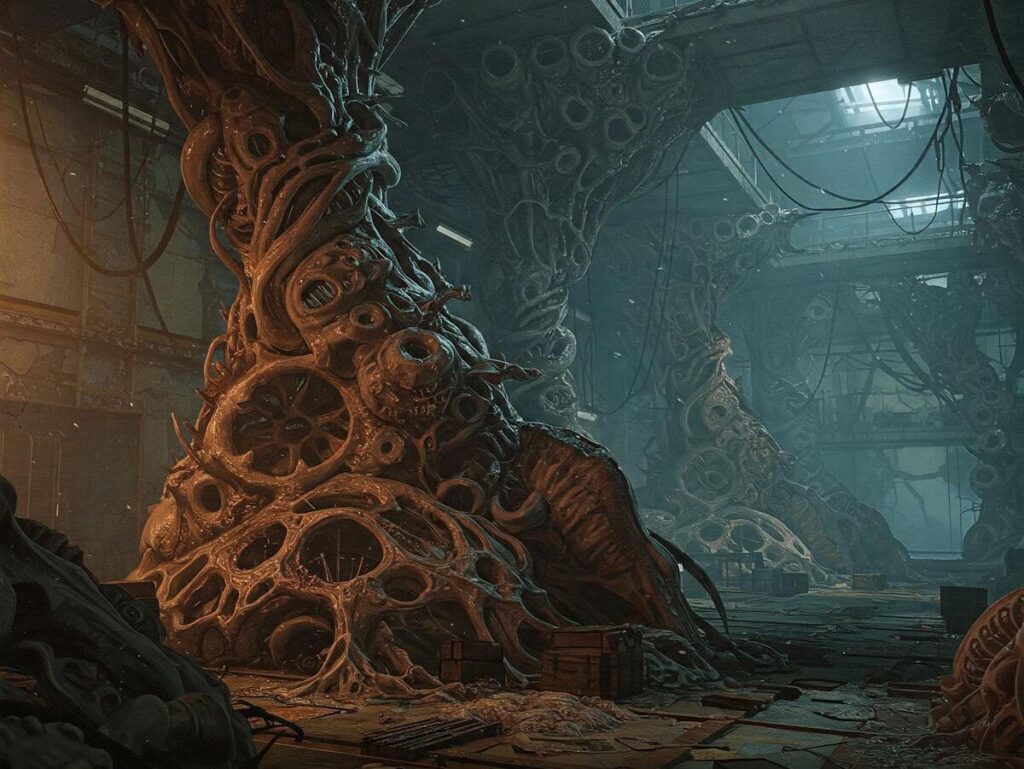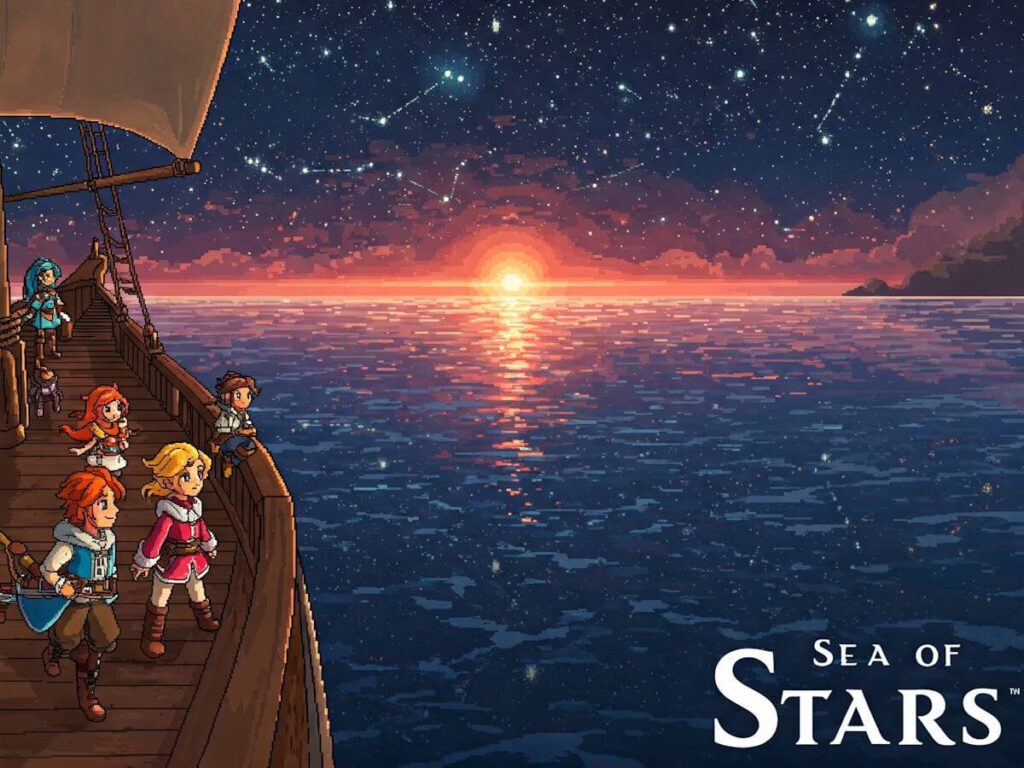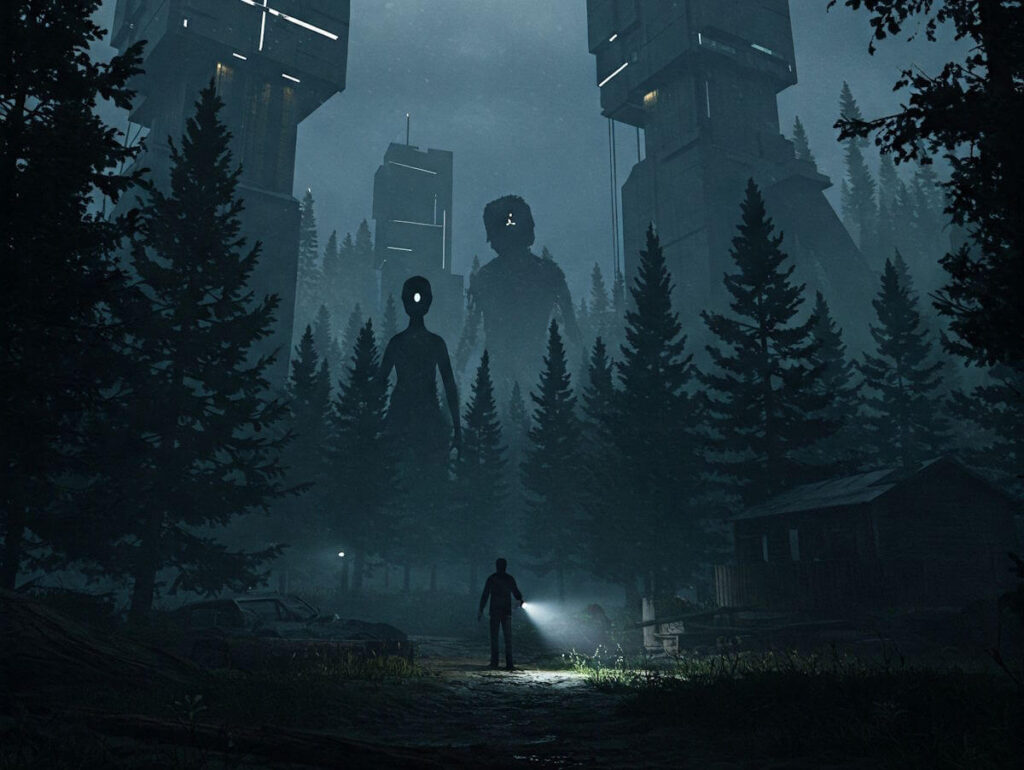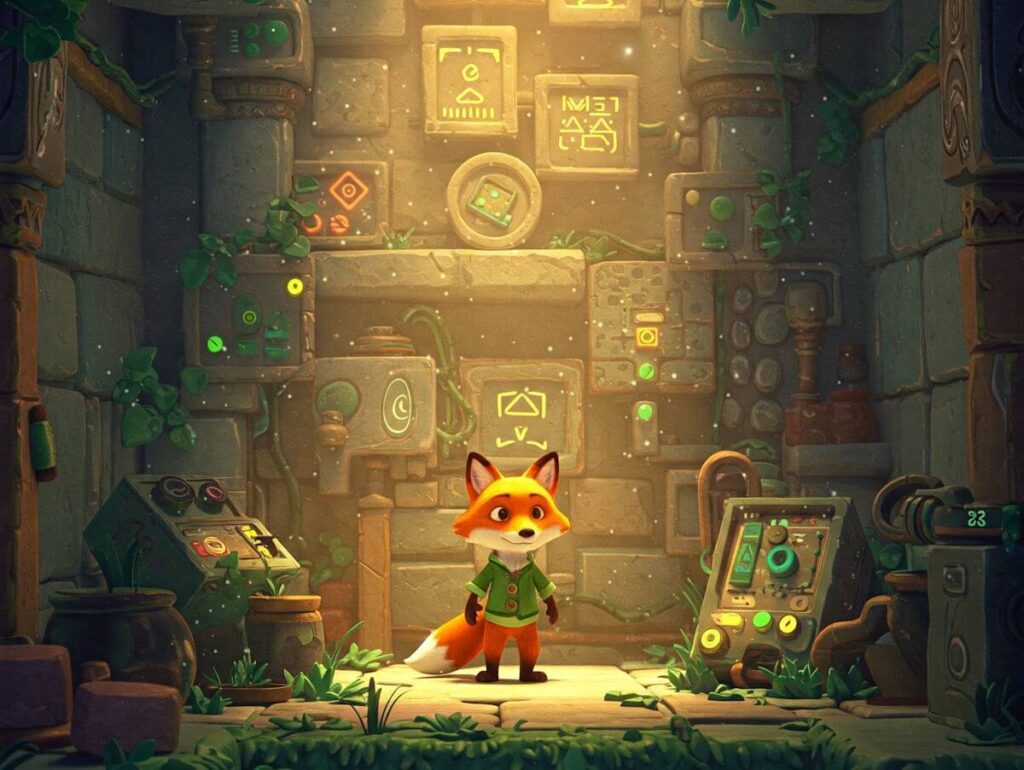Scorn is a uniquely conceptualized video game that stands out within the genre for its dedication to an art-driven experience. Developed by Ebb Software, Scorn initially captured the attention of gamers and art enthusiasts alike thanks to its intriguing design and eerie settings. The game draws heavy inspiration from the works of renowned artists H.R. Giger and Zdzisław Beksiński, whose distinctive styles are characterized by the grotesque and the surreal. This homage is evident in Scorn’s visuals, which feature intricate, organic environments filled with bizarre architecture and nightmarish creatures.
Set within a haunting, labyrinthine world, the game’s premise invites players to explore and interact with an environment that feels alive, yet unsettling. The narrative unfolds in a manner that is non-linear, encouraging exploration and personal interpretation. As players navigate this unnerving landscape, they encounter numerous puzzles and challenges that demand not only skill but also deep contemplation about the environment and its lore. The artistic vision behind Scorn emphasizes immersion, with an emphasis on atmosphere and mood more than traditional storytelling elements.
When Scorn was first announced, it generated significant buzz due to its aesthetic choices and ambitious concepts. The initial reception to early trailers and gameplay footage highlighted the striking visuals and the promise of an immersive exploratory experience. However, as with any innovative project, the blend of art and gameplay has led to mixed expectations. While many players appreciate the game’s artistic ambition, others remain cautious about its potential gameplay execution. The subsequent sections will delve deeper into these aspects, examining how Scorn attempts to harmonize visual artistry with interactive experiences, ultimately raising questions about the definitions of art and gameplay in modern gaming.
The Artistic Elements of Scorn
Scorn is a game that stands out due to its profoundly intricate artistic direction, which plays a pivotal role in shaping the overall atmosphere. The visual design of Scorn is heavily influenced by the work of H.R. Giger, known for his distinctive, grotesque aesthetic that merges organic and mechanical forms. This influence is evident in both the game’s architecture and character design, creating a world that is not only visually striking but also unsettling. The environments are filled with intricate textures and surreal structures that evoke feelings of dread and curiosity simultaneously. Every corner of the game world is designed to immerse players in a nightmarish landscape that reflects themes of horror and existentialism, encouraging them to ponder the nature of life and humanity.
Moreover, Scorn’s environments complement its storyline by acting as a narrative device in themselves. Each area subtly conveys the internal struggles of the characters through its design. The use of monochromatic tones, paired with occasional bursts of color, exemplifies the duality of life and death, creation and destruction, which are recurring motifs throughout the gameplay. The meticulous environmental artistry works hand-in-hand with the game’s mechanics, guiding players through a nightmare that feels both familiar and alien.
Character design in Scorn further enhances the emotional impact of the narrative. The creatures and inhabitants of this world are not merely antagonists; they are embodiments of existential fears and philosophical inquiries regarding humanity’s destiny. This alignment of character aesthetics with the themes of horror creates a unified vision that resonates deeply with players, fostering an immersive experience. The artistic choices made in Scorn ultimately serve to elevate the gameplay, blurring the lines between art and interaction, thus affirming its position as a compelling art game despite potential gameplay criticisms.
Gameplay Mechanics: An Overview
The gameplay mechanics of Scorn form a fundamental aspect of its overall experience, melding various elements such as exploration, puzzle-solving, and combat systems into a singular vision. The game’s design directs players through its intricately crafted environments that evoke a sense of unease and curiosity. The exploration mechanics greatly emphasize a non-linear approach, allowing players to investigate alien landscapes teeming with intricate details. This labyrinthine structure enhances the player’s engagement, inviting them to uncover hidden secrets while immersing fully in the game’s unsettling atmosphere.
In terms of puzzle-solving, Scorn offers a variety of challenges that require considerable thought and experimentation. The puzzles are seamlessly integrated within the game world, demanding players to interact with bizarre devices and complex mechanisms that echo the game’s grotesque aesthetic. Such puzzles are not mere distractions; rather, they serve to deepen the narrative and provide insight into the world of Scorn. As players navigate through these challenges, they are rewarded not only with progression but also a more profound understanding of the underlying story, thus enhancing the overall engagement.
Combat systems in Scorn introduce an additional layer of complexity, balancing the pressures of survival with the exploration and puzzle-solving facets. The mechanics are designed to encourage tactical thinking, as resources are limited, demanding players to strategize against grotesque adversaries. This design choice aligns effectively with the game’s tone, enhancing the feeling of vulnerability and desperation. The integration of combat within the broader gameplay mechanics thus results in a cohesive experience that reinforces the themes of isolation and dread while avoiding abrasive mechanics that could detract from the artistic vision.
Overall, the gameplay mechanics of Scorn exhibit a thoughtful design that fosters deep engagement through exploration, intricate puzzles, and strategic combat, effectively enhancing the player’s journey through its darkly captivating world.
Narrative Depth: Storytelling in Scorn
The narrative in Scorn unfolds in a uniquely captivating manner, drawing players into a surreal journey that is intricately tied to its environment rather than relying on conventional storytelling methods. This approach emphasizes the game’s themes of isolation, existential dread, and the interplay between life and decay. As players navigate through the grotesque, biomechanical landscapes, they encounter a plethora of visual symbolism that hints at deeper meanings and invites interpretation.
One of the defining aspects of Scorn’s narrative depth lies in its environmental storytelling. Unlike traditional games that employ dialogues or cutscenes to convey a plot, Scorn immerses players in its world where every element—from the design of the structures to the grotesque flora and fauna—serves as a narrative device. The desolate surroundings evoke a sense of foreboding and curiosity, compelling players to piece together the story from context clues scattered throughout the game. This method fosters a more subjective experience, allowing players to interpret the underlying themes on a personal level.
The game’s symbolism plays a pivotal role in enhancing the storytelling experience. Each environment, filled with intricate details and haunting imagery, reflects the protagonist’s psychological journey. The various forms of life and decay found within the game’s realm echo the cyclical nature of existence, delivering a poignant commentary on mortality and rebirth. Through this visceral medium, Scorn challenges players to confront uncomfortable truths, making the narrative not just an afterthought but an integral part of the gameplay experience.
In essence, the narrative depth of Scorn is a testament to the power of environmental storytelling. By eschewing traditional dialogues and focusing on visual symbolism, the game invites players to engage with its themes in a deeply personal manner, establishing a connection that is both thought-provoking and immersive.
Player Reception and Critiques
The reception of Scorn, an ambitious entry into the art game genre, has been markedly divided among players and critics alike. While some laud the game for its striking visuals and unique aesthetic inspired by the works of H.R. Giger, others express dissatisfaction with various gameplay elements. Central to this discussion is the game’s pacing, which has garnered both praise and scrutiny. Many players appreciate the slow-burn approach, feeling it allows for a more immersive experience. However, others argue that the pacing can detract from engagement, resulting in moments of frustration.
One significant area of contention lies in the clarity of puzzles presented throughout Scorn. Critics have pointed out that while some puzzles are creatively integrated into the environment, the vagueness in their design can lead to disinterest and confusion. Players seeking a fair challenge may find themselves struggling to grasp the intended solutions, leading to a sense of disillusionment with the overall gameplay experience. Such frustrations spark a debate regarding the balance that must be struck between artistic expression and enjoyable game mechanics.
Moreover, the juxtaposition of artistry versus gameplay mechanics remains a focal point in critiques. Some argue that Scorn excels as an art piece, offering a hauntingly beautiful narrative world that compels players to explore its grotesque yet captivating aesthetic. Conversely, those who prioritize gameplay mechanics raise valid concerns about user experience, suggesting that a more cohesive integration of artistry and interactive elements is crucial for fulfilling the potential of a game hailed as an art experience. This duality in reception highlights the complexities in defining the boundaries of art games and where Scorn fits within this evolving landscape.
Comparison with Other Art Games
In exploring the realm of art games, it is essential to juxtapose Scorn with titles that have left a significant mark on the genre, such as Inside, Limbo, and Journey. These games, while distinct in their narrative and artistic design, share an inherent trait of prioritizing aesthetics alongside gameplay experience.
Starting with Inside and Limbo, both developed by Playdead, we observe a deep focus on visual storytelling, conveyed through a minimalist yet evocative art style. Inside, with its hauntingly atmospheric environments and meticulous attention to detail, immerses players in a dystopian world where the narrative unfolds silently, urging players to discover meaning within a stark visual context. Likewise, Limbo employs a monochromatic palette that mirrors its themes of life and death, creating a compelling sense of tension. In contrast, Scorn opts for a more grotesque and surreal aesthetic, drawing players into its organic, disturbing environments which evoke feelings of discomfort and curiosity.
Journey presents a significantly different approach by emphasizing emotional engagement through its breathtaking landscapes and a unique multiplayer experience. Players traverse vast deserts and encounter other travelers, fostering connections without verbal communication. Scorn, while rich in atmosphere, opts for a solitary experience characterized by puzzle-solving and exploration, lacking direct interaction with other players.
In terms of gameplay structure, Inside and Limbo offer a linear progression through carefully crafted levels, whereas Journey facilitates a more open-ended exploration. Scorn’s gameplay falls somewhere in between, incorporating intricate puzzles that require observation and critical thinking, while also fostering immersion through its unsettling world. This blend of artistic vision and engagement distinguishes Scorn within the art game genre, as it aims to evoke profound emotional responses through its unsettling visuals and immersive gameplay.
The Balance Between Art and Play
The ongoing debate surrounding the balance between art and gameplay in video games is a significant one, particularly when examining the unique case of Scorn. This game has garnered attention for its striking aesthetic and surreal environments, which draw heavily from the works of H.R. Giger and Zdzisław Beksiński. However, alongside the appreciation for its artistic expression, many players question whether Scorn’s emphasis on visual storytelling sacrifices engaging gameplay.
In the broader context of the gaming community, there exists a delicate equilibrium that must be maintained between artistic ambition and enjoyable mechanics. A game that leans too heavily toward artistic expression may produce an experience that is visually captivating yet lacking in procedural engagement, potentially alienating players who prioritize gameplay. Conversely, a game focused solely on interactive elements might fail to leave a lasting impression or evoke emotional responses, ultimately falling flat in any artistic merits.
Scorn serves as a pivotal example of this tension, as its design choices showcase a profound investment in atmosphere and thematic depth. Players are immersed in a brilliantly crafted world that conveys disturbing yet beautiful imagery truly unique to the medium. However, critiques have highlighted that this emphasis on art can lead to moments where gameplay suffers, leading to disjointed experiences that challenge the player’s ability to engage with the core mechanics. As such, Scorn embodies the complexities of balancing artistic vision with the need for satisfying gameplay.
Ultimately, the discourse surrounding Scorn reflects a larger conversation within the gaming industry. It raises essential questions about what players value in their experiences, prompting game developers to consider how art and gameplay can coexist harmoniously. As the debate continues, Scorn stands as a striking point of reference for understanding the intricate dynamics between aesthetic ambition and interactive engagement.
Future of Scorn and Its Impact
As the gaming landscape continues to evolve, Scorn has emerged as a notable example of the intersection between art and interactive experience. The game has sparked extensive discussions among players and developers alike regarding its unique aesthetic and conceptual approach. Moving forward, it is plausible that Scorn will inspire a new wave of developers to prioritize artistic ambition over conventional gameplay mechanics. By presenting a grim and immersive world through visceral artwork and atmosphere, Scorn highlights the potential for video games to transcend mere entertainment and transform into profound artistic expressions.
One of the most significant impacts of Scorn could lie in its ability to encourage others within the industry to explore unconventional narratives, daring aesthetics, and experimental gameplay. As developers become increasingly aware of the growing appetite for art-driven experiences within the gaming community, we may witness a shift away from formulaic designs that prioritize commercial success over creative exploration. Games could begin to incorporate more abstract, ethereal, and introspective elements, much like Scorn, making the medium richer and more diversified.
In a broader context, the long-term legacy of Scorn may serve as a benchmark for the industry, showcasing how art can coexist with interactive storytelling. While commercial viability remains a critical concern, Scorn demonstrates that there is a significant audience for games that challenge traditional paradigms. It is essential to recognize that this shift could lead to a creative renaissance, where future titles prioritize unique aesthetic experiences, potentially enhancing overall player engagement and satisfaction. Ultimately, Scorn’s influence might encourage a re-evaluation of what constitutes success in the gaming world, validating artistic endeavors alongside traditional gameplay achievements.
Conclusion: Art Game or Gameplay Disaster?
In the exploration of Scorn, the question remains as to whether it stands as a successful example of an art game or embodies elements of a gameplay disaster. Throughout this examination, we have delved into various aspects of the game, including its distinctive visual design, atmospheric immersion, and the intricate world-building that defines its aesthetic appeal. The artistry of Scorn cannot be overlooked; it is a carefully crafted experience that engages players on a sensory level and elicits emotional responses through its unsettling environments.
Conversely, the gameplay mechanics have drawn mixed reactions. While some players appreciate the challenging puzzles and the deliberate pacing as a means to enhance the immersion, others find these same elements detract from the overall experience. The navigation can often feel cumbersome, and the lack of clear objectives may frustrate those seeking conventional gameplay structures. This divergence in player reception raises critical questions about the balance between artistic expression and interactive enjoyment.
The core of the debate hinges on the player’s expectations. Those who approach Scorn seeking an art-driven experience may find profound meaning in its design and atmosphere, while players looking for traditional gameplay mechanics might feel disappointed. As we wrap up this investigation, it is evident that Scorn challenges the boundaries of game design by merging art and interactivity in a unique manner. Ultimately, whether one perceives it as a stellar art game or a gameplay disaster may depend on individual perspectives and gaming preferences. The discourse surrounding Scorn encourages players to reflect on their personal definitions of art and enjoyment in gaming, inviting an ongoing conversation about the evolving nature of interactive media.





